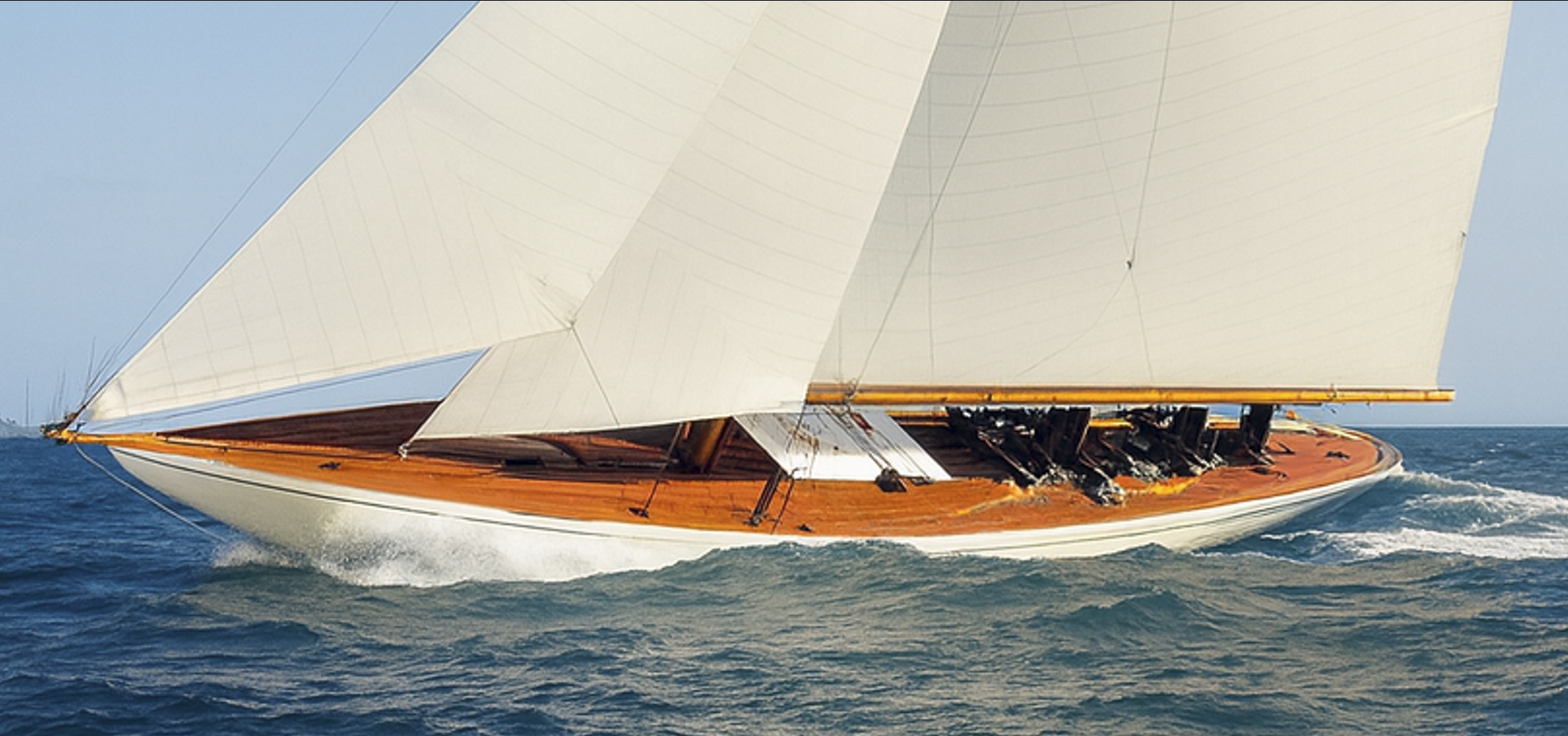
Rhona 12 K 7
Design & Build (1927)
In May 1927, the classic 12-Metre yacht RHONA was launched from the famed William Fife & Son yard in Fairlie, Scotland. Designed by W. & R.B. Fife, she was built to the International Rule, Second Rule, as construction hull #748. Measuring 19.86 meters overall with a 12.95-meter waterline, a beam of 3.76 meters, and a draft of 2.60 meters, she carried a sail area of 190 square meters. Crafted in mahogany with Fife’s trademark dragonhead carving at the bow, RHONA embodied the grace, balance, and artistry that made the Fife name legendary.
Commissioned by J. Lauriston Lewis, RHONA sailed proudly from Greenock as a Bermudan cutter, quickly becoming a symbol of prestige in the Clyde yachting community. At Cowes Week in 1929, she placed third overall, with a notable first in one of the six races—early proof of her racing pedigree.
Early Owners (1927–1932)
Her first years under J. Lauriston Lewis established RHONA’s reputation in the British sailing scene. In 1930, she was purchased by Algernon George de Vere Capell, the 8th Earl of Essex, who shifted her home port to Greenwich. The Earl, an Eton-educated officer, World War I veteran, and theatrical enthusiast, sailed RHONA amidst the refined circles of high society and London’s yacht clubs.
Hei II in Norway (1933–1958)
One of RHONA’s most remarkable chapters began in 1933, when she was acquired by Arnfinn Kolbjørn Heje, a Norwegian industrialist and Olympic sailor. Heje, who had won gold at the 1912 Stockholm Olympics in the 12-Metre class aboard Magda IX, renamed the yacht Hei II and based her in Oslo. For a quarter of a century, she was a familiar sight in Scandinavian waters, racing and cruising successfully. Under Heje’s stewardship, she enjoyed stability and prestige, becoming a fixture of Norway’s classic yacht scene until his death in 1958.
Conversions & Transformations (1960s–1970s)
In the 1960s, RHONA entered a period of transformation. Jan Arthur Iversen of Sarpsborg converted her into an auxiliary yawl, fitting an engine, cabin superstructure, and mizzen mast, renaming her Frisco VI. Though no longer a pure racing yacht, she became a comfortable long-distance family cruiser.
In 1969, Swedish painter Urban Ström purchased her, using the yacht as a floating studio in Gothenburg. A year later, she was bought by Stig Westberg & friends, who returned her name to Hei II and refitted her at the Broderna Jacobsson yard, equipping her with a new engine, strengthened mast step, and fresh sails.
By 1974, she changed hands again to Swedish yachtsmen Anders Hemberg, Curt Hässler, and Lars Hässler (later a noted sailor and author). Renamed Golum, she underwent a further refit at the Plym Yard and served actively as a charter yacht in Scandinavian waters.
Decline in Spain (1980s–2018)
RHONA’s fortunes shifted dramatically when Spanish real-estate broker Joaquim Trill Gil brought her to the Costa Brava in the 1980s. During the delivery voyage, she partially sank and, though salvaged, she was never properly restored. For decades she lay neglected in Puerto de L’Escala, decaying on the quayside. By the 2010s, she was a shadow of her former self—offered for sale at unrealistic prices, unwanted by locals, and seemingly destined for the scrapyard.
Revival on the Costa Brava (2018–Present)
In 2018, Swiss sailor, craftsman, and designer Dan Meury saw in the wreck of RHONA what others had missed: the unmistakable lines of a Fife masterpiece. Taking on the yacht without the support of a major yard, Meury began a full-scale, hand-crafted restoration on the shores of the Costa Brava. Working outdoors in sun, salt, and wind, he combined traditional methods with meticulous precision, saving every detail possible and recreating what had been lost in faithful detail.
After six years of work, RHONA is being restored not only to her original design and name, but also to her spirit. Her relaunch, planned for 2026, will mark the beginning of a new century of elegance under sail, returning a nearly lost icon of the 12-Metre class to the racing and cruising stage.
Legacy
From her birth in Fairlie in 1927, through her golden racing years, her Scandinavian chapters, her decades of neglect, and her miraculous rebirth in Spain, RHONA embodies the resilience of great yachts. A true survivor, she carries nearly a century of stories and personalities within her lines. Once relaunched, she will once again stand as a proud representative of William Fife’s genius, and of the enduring heritage of the International 12-Metre class.

